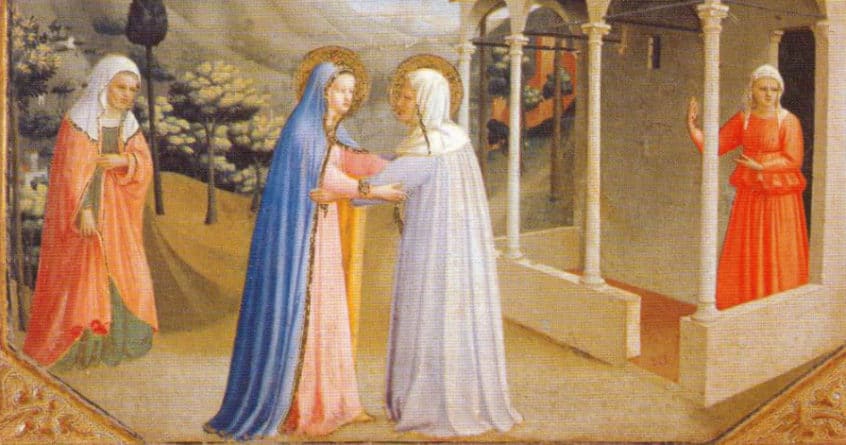The Visitation
The Visitation is the visit of Mary to Elizabeth as recorded in the Gospel of Luke, Luke 1:39–56. It is also the name of a Christian feast day commemorating this visit, celebrated on 31 May in the West (2 July in calendars of the 1263–1969 period, and in the modern regional calendar of Germany) and 30 March among Eastern Christians.
Mary visits her relative Elizabeth; they are both pregnant: Mary with Jesus and Elizabeth with John the Baptist. Mary left Nazareth immediately after the Annunciation and went “into the hill country…into a city of Judah” (Luke 1:39) to attend to her cousin (Luke 1:36) Elizabeth. There are several possibilities as to exactly which city this was, including Hebron, south of Jerusalem, and Ein Karem. The journey from Nazareth to Hebron is about 130 kilometers (81 mi) in a direct line, probably up to half as far again by road, depending on the route taken. Elizabeth was in the sixth month before Mary came (Luke 1:36). Mary stayed three months, and most scholars hold she stayed for the birth of John. Given the prevailing cultural traditions and needs for security etc., it is probable that Joseph accompanied Mary to Judah then returned to Nazareth, and came again after three months to take his wife home. The apparition of the angel, mentioned in Matthew 1:19–25, may have taken place then to end the tormenting doubts of Joseph regarding Mary’s maternity.[1]
In the Gospel of Luke, the author’s accounts of the Annunciation and Visitation are constructed using eight points of literary parallelism to compare Mary to the Ark of the Covenant.[2][3]
In Catholicism, it is held that the purpose of this visit was to bring divine grace to both Elizabeth and her unborn child. Even though he was still in his mother’s womb, John became aware of the presence of Christ and leaped for joy as he was cleansed from original sin and filled with divine grace. Elizabeth also responded and recognized the presence of Jesus, and thus Mary exercised her function as mediatrix between God and man for the first time.[1]
And she [Elizabeth] spoke out with a loud voice, and said, Blessed [art] thou among women, and blessed [is] the fruit of thy womb. And whence [is] this to me, that the mother of my Lord should come to me? For, lo, as soon as the voice of thy salutation sounded in mine ears, the babe leaped in my womb for joy. And blessed [is] she that believed: for there shall be a performance of those things which were told her from the Lord. (Luke 1:42–45)
In response to Elizabeth, Mary proclaims the Magnificat (My soul doth magnify the Lord), Luke 1:46–55.
The word “blessed” is rendered in Greek, not by the word “makarios”, but as “evlogimeni”, which is the feminine second person singular, used only this once in the New Testament. Its masculine third person singular counterpart “evlogimenos” is used only for Jesus and only on this occasion and when He was welcomed into Jerusalem on Palm Sunday with: “Blessed is he who comes in the name of the Lord”. The masculine/mixed gender third person plural “evlogimenoi” is used by Jesus only when referring to the righteous who are to be raised to life in the Last Judgement.[citation needed]

